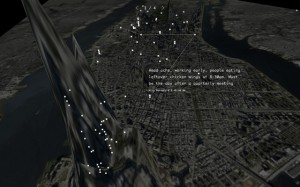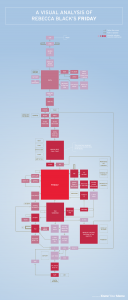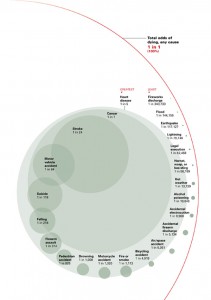Hat tip to Rob Baker-White for reminding me of this.
Category Archives: Articles
SA Freedom Charter
Map of the Human Heart
1993
Directed by Vincent Ward
With Jason Scott Lee
Costume deadlines from Barbara
COSTUME SHOP DEADLINES FOR FALL 2011
THEATRE 228:
Design/costume information due:October 31
Fittings beginning:November 7-15
First dress rehearsal:November 21
Dress rehearsals resume:November 28
Opening night:November 30
Closing night:December 3
Locals, tourists, and geotagged photos

Locals and Tourists #2 (GTWA #1): New York
Blue pictures are by locals. Red pictures are by tourists. Yellow pictures might be by either.
Base map © OpenStreetMap, CC-BY-SA
Invisible cities of social networks
 Invisible Cities
Invisible Cities
A project by Christian Marc Schmidt & Liangjie Xia
By revealing the social networks present within the urban environment, Invisible Cities describes a new kind of city—a city of the mind. It displays geocoded activity from online services such as Twitter and Flickr, both in real-time and in aggregate. Real-time activity is represented as individual nodes that appear whenever a message or image is posted. Aggregate activity is reflected in the underlying terrain: over time, the landscape warps as data is accrued, creating hills and valleys representing areas with high and low densities of data.
Visual analysis of Rebecca Black’s Friday
 This is terribly silly, but also an excellent example of a way of mapping a passage of text, with external factors (the “memetic significance” of various passages, i.e. “How much did was that particular section mocked in the internet/YouTube/pop cultural arena?”) taken into account and given visual expression.
This is terribly silly, but also an excellent example of a way of mapping a passage of text, with external factors (the “memetic significance” of various passages, i.e. “How much did was that particular section mocked in the internet/YouTube/pop cultural arena?”) taken into account and given visual expression.
http://www.upload.ee/image/1269951/rebecca_black_vertical-03.png
Spiral of death
Visual display of quantitative information: some definitions
Map (1520s, shortening of M.E. mapemounde “map of the world” (late 14c.), from M.L. mappa mundi “map of the world,” first element from L. mappa “napkin, cloth” (on which maps were drawn), said by Quintilian to be of Punic origin (cf. Talmudic Heb. mappa, contraction of menafa “a fluttering banner”))
a visual representation of an area—a symbolic depiction highlighting relationships between elements of that space such as objects, regions, and themes. Many maps are static two-dimensional, geometrically accurate (or approximately accurate) representations of three-dimensional space, while others are dynamic or interactive, even three-dimensional. Although most commonly used to depict geography, maps may represent any space, real or imagined, without regard to context or scale [Wikipedia and Online Etymology Dictionary]
Overlay of European cities on North America (and vice versa)
 I thought this was interesting — just in terms of how far north or south stuff is in the U.S. versus Europe. Not what I would expect — Budapest is further north than the Twin Cities? And actually, a good chunk of Europe is in Canada? Some stuff is what you expect, though — the Mediterranean climate of California and the Napa Valley wine growing region, etc.
I thought this was interesting — just in terms of how far north or south stuff is in the U.S. versus Europe. Not what I would expect — Budapest is further north than the Twin Cities? And actually, a good chunk of Europe is in Canada? Some stuff is what you expect, though — the Mediterranean climate of California and the Napa Valley wine growing region, etc.
Transposition on maps of various kinds is an interesting idea…

